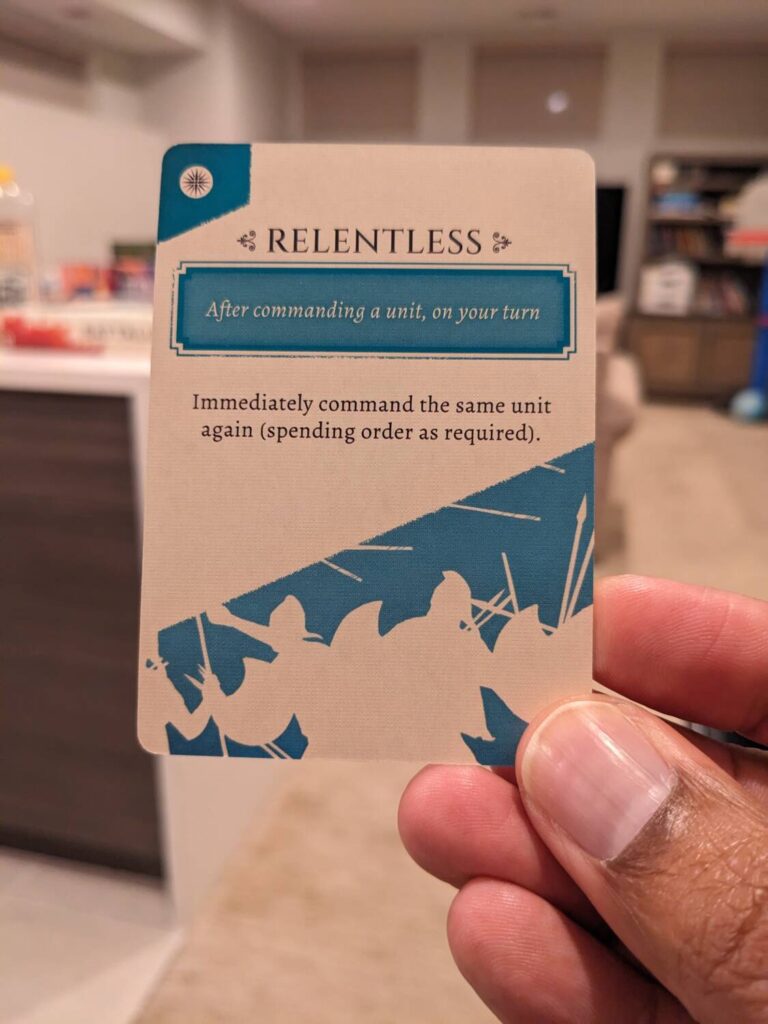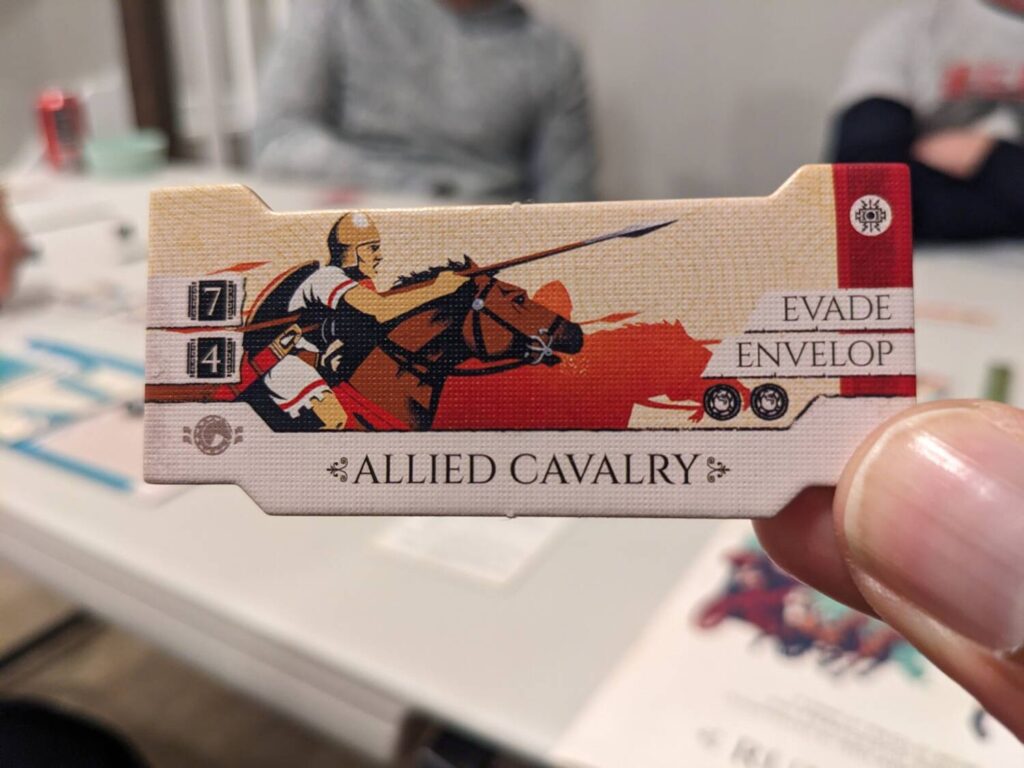Disclosure: Meeple Mountain received a free copy of this product in exchange for an honest, unbiased review. This review is not intended to be an endorsement.
The cover art for the new skirmish game Battalion: War of the Ancients (2024, Osprey Games) drew me in. It’s one of the best box covers for a game this year. However, as great as the artwork is, I was even more excited by the designers listed at the top: Paolo Mori and Francesco Sirocchi.
Mori has made a number of great games—Blitzkrieg! World War II in 20 Minutes (yes, that’s the official name of the game) is my favorite, but I’ve enjoyed single plays of other Mori games, such as Ethnos (and Archeos Society, which I guess is “New Ethnos”) and the two Libertalia games, the “OG” as well as the Stonemaier update from a couple years ago. The thing I have enjoyed most about Mori’s designs: the games are easy to teach and get right into the action, with gameplay durations that match the number printed on the side of the box.
And that’s why I loved Blitzkrieg! Like most people, I did not believe that someone could design a fun head-to-head war game that really could be played in 20 minutes. But Blitzkrieg! was a revelation—it was always over in about 20 minutes. Caesar!—-the follow-up to Blitzkrieg!—was a game I only tried once, but it was also over in about 20 minutes, just like it promised on the box.
Speaking of the box…

A Tale of Two Battalions
With that framing, I was excited to see the side of the Battalion: War of the Ancients box—“20-45 Minutes”, it says. Because the player count is either strictly two or four players, I made a simple assumption: with two players, Battalion would take 20 minutes or so, and with four players, the game would take about 45 minutes.
After reading the rules, I was concerned that it would be impossible to play Battalion in 45 minutes—but this is Paolo Mori we are talking about! He’s never been a part of an experience where the game was off on its playtime.
As if this amount of foreshadowing was not enough, dear readers, I have both good news and bad news. First, we have to define the time listings on the side of the box.
These times are NOT tied to the player count, unlike almost every game I have reviewed this year (150+ games). Rather, it is tied to the number of sectors used for the game’s battlefield. With three sectors, the designers feel that the game will play out in about 20 minutes. With five sectors, the game will take…well, longer. The designers think it will take about 45 minutes.
In reality? My single four-player game, five-sector game was aborted at the 90-minute mark. For perspective, I have logged over 500 plays in 2024, and this first play of Battalion was only the second time I stopped a game before the ending was decided all year. (The other was Mind Map, a game that we will never discuss again.)
Contrast this with my first two-player, three-sector game of Battalion. That was a very interesting, back-and-forth slugfest, one that featured all manner of death at the hands of every type of rank in the game. But most importantly, as it related to time—the entire game took 25 minutes.
So, the good news here is the two-player format. With two players, the playtime is more in line with a game that should be a quick lane battler, produced with exceptional care. The bad news? No matter the player count, Battalion still has a host of minor issues that circle a much larger one—why is the middle sector of the battlefield the only one that truly matters?

Evade
Battalion: War of the Ancients is a rules-light, dice-driven combat game. Players take on the role of one of four different historical factions in the box: the Roman Republic, Carthage, the Greco-Bactrian Kingdom, and the Han Empire. (Admittedly, I don’t have a good feel for the history behind the ways these fighting forces really waged battle, so I can’t comment on how “thematic” any of the factions really should feel.)
In a four-player game, two humans command one faction together against another faction controlled by two human opponents. In this way, players will only ever use two factions in any single game.
Each faction has different “ranks” that can be selected and built into a fighting force made up of a certain number of units. The ranks are small, handsomely-drawn tiles that feature the rank’s name, special abilities, and the die value requirements when the rank is used in combat during melee or ranged/missile attacks.
Ranks are added together to form units, and units can either be a single rank type (easier to command, but sometimes less powerful) or mixed ranks. Units share a combined amount of “Cohesion”, the game’s somewhat confusing health and wellness stat. If a unit ever loses all its Cohesion, the unit disbands and disappears from the game.
The battlefield is separated into sectors: three in a two-player game, five in a four-player game (one could also use five sectors in a two-player game, if the players want to play a longer engagement). The middle sector is always the last defense for any skirmish—if a player ever has zero units left in their central sector, the opposing force immediately wins the game at the start of their turn.
To begin play, each player has 1-2 Tactics cards, which can be used to either take the action printed on the card, or permanently discarded to add dice to combat rolls. Tactics cards can also be used to redeploy units to different sectors of the map. Their other function is to serve as the game’s play clock: if a faction ever needs to draw a new Tactics card, but cannot, that faction immediately loses the game.
Each side has a limited number of order tokens used to command units on the battlefield, tokens which can be refreshed by using an entire turn to take the Rally action. Otherwise, options here are simple: you may burn a Tactics card to redeploy a unit between adjacent sectors before taking one of three actions, Assault, Barrage, or Charge. The active player selects a unit, drops an Order token on the unit, then takes actions based on the situation, taking into account any powers included in that unit as well as powers listed on the target unit rank tiles.

Then, the dice are chucked. Battalion uses standard D8s to resolve combat actions. Damage taken by the opponent can be resolved by absorbing hits and killing off ranks, or adding disorder tokens (the back side of the order tokens) to the unit to serve as a hit instead. If a unit ever reaches maximum disorder—tied to its available number of Cohesion across all ranks in the unit—it is defeated and disbanded, lost forever to the sands of time. (More importantly, the losing unit has to draw a Tactics card, which might force the game’s end conditions.)
This led to each of my plays going the same way. Everyone attacks units in the middle sector, because a win there ends the game. Occasionally, players activate their edge units because some ranks have powers that boost the dice pool but only when engaging an opponent on one of the outer sectors of the battlefield. Worst case, combat defeats force an opponent to draw cards. That fuels an engine that the loser needs to move units to the central sector, to ensure that there is always enough support in their most important pain point.
Dice are dice, so some combats are great, others are terrible, but that’s the way things shake out over a longer game. This was also the principal reason why our four-player game went on for so long—poor dice rolls mean that factions are trading misses, which isn’t that much fun for anyone, really. The combat abilities of each rank looked juicy when I started my plays of Battalion, but slowly became less interesting—some units use an extra die, while others have very specific timing uses that can situationally be amazing or totally worthless. (I’m looking at you, Envelop and Anticipate!!)
The big thing with combat: we found very limited chances to roll enough dice to completely kill off a fully-healthy unit each turn. It was usually a grind to get a unit down on Cohesion, which sometimes took 3-4 turns to take out a single unit. My first four-player game used the pre-set Battle #5 setup, with each faction getting 10 total units.
So, imagine my dilemma: I’ve signed on for a fast-as-a-flash combat game where I’m expecting dice to wreak havoc. Instead, many units take a lot of punishment before ultimately being vanquished…in a game that should only take about 45 minutes with four players.
When we called that four-player game at the 90-minute mark, each side still had five units and four of them were in each faction’s half of the middle sector. If I had to guess, we were another 20+ minutes away from finishing, because each side had two cards in hand and a three-card draw pile.

Fright
Battalion: War of the Ancients has a lot of promise, particularly as a two-player-only skirmish game. (I’ll never try the four-player variant again. Even if I wanted to, the three people who tried it with me literally aborted the game before it finished!!)
The game doesn’t do itself many favors. I would have liked to see more pre-set options in the manual; as it is, there are only six included. Experienced players will use the draft variant to build their own units (the “Mustered Battles” option), but unless a player regularly gets Battalion to the table, new players will stick with the pre-set engagements.
The order/disorder tokens, and the general readability of rank tiles, are a strange miss. The order/disorder tokens use a very poor technique to tell the two sides apart—basically, a slightly burned flag is the disorder side of the chips—and players consistently struggled to see which side was which from across the table. Even something as simple as using a plus sign for order and a minus sign for disorder would have worked so much better during play.
When a unit is full of these tokens (between being commanded once or twice, then tokens that were used up for Cohesion damage), it’s impossible to see what ranks have which powers unless someone moves a token off the unit altogether.
That’s critical in a game where you need to know what an opposing force is capable of, and it is hard to know that off the top of your head if you don’t know what each of the four unique factions can do or what that faction specializes in.
Like other Osprey Games products such as Crescent Moon, Undaunted: Normandy, and Wildlands, Battalion is equally lush. The rulebook is laid out well, with a back-of-the-manual summary and supporting player aids that answer most in-game questions. The storage solution is perfect and separates each faction’s rank tiles in an easy-to-grab way. The eight-sided dice are plenty fine, and the faction “camp” boards do the trick.

But even then, minor issues still surfaced. The rules are crystal clear, until players have questions about each combat ability. (The player aid got a lot of action in my games.) The word choices for these traits never really stuck with players. By the end of a two-player engagement between the Romans and the Carthage, I was still stuck on what the Harass trait would do. Guard sounds like a defensive ability…nope, it’s a boost to a player’s dice pool during a counterattack.
Even at the end of my only four-player game, players could not clearly define what counter-charging was. (This allows an opponent to select which unit is being charged, if they have order tokens to spend.) You’ve got charges, counter-charges, assaults, and counterattacks, but it was comedy trying to remind everyone of what each one specifically does.
For a game that can be taught so quickly, Battalion: War of the Ancients required a lot of “re-teach” moments during play. We were also surprised that sectors do not have a limit of how many units can be in them. And because a player can choose to redeploy any number of units by discarding a Tactics card for each one, we found that the late game just pushed everyone to use their cards to move all their units towards the middle of the battlefield.
That decision gets easier when you consider the idea of using the card for its text ability or to redeploy troops. The Tactics cards in Battalion were a mixed bag—some featured really cool tactical responses to dire moments in the field. Other cards give you the chance to re-roll a die. (Yes, re-roll, not set the die to a certain die face.) I’m never going to hold a card for the special moment when I could reroll a die when I could instead move an entire unit of troops to the central area of the map.
Battalion: War of the Ancients feels like a game that is really meant to be played by only two players. For that reason, I recommend a purchase if your intent is to try this with only two players, but don’t recommend this if you are looking for a four-player battler.
I will keep Battalion: War of the Ancients around for the limited chances I get each year to play wargame-style experiences with a friend of mine who loves these types of games. For most players, I recommend sticking to the smallest pre-set battles with a dedicated partner, to try working through a mix of the set and the “mustered” (customized) battles with each faction. As it is, many other combat experiences provide richer narrative in a more exciting, intuitive package.










